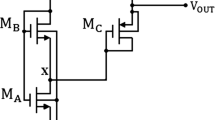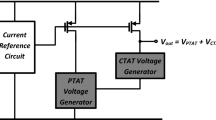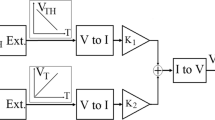Abstract
Electromagnetic interference (EMI) can significantly degrades the performance of analog circuits, including voltage and current references, especially due to their limited power supply rejection. An EMI resistant MOSFET-only voltage reference is herein proposed, based on the MOSFET zero temperature coefficient (ZTC) vicinity condition. The ZTC condition is analytically derived through a continuous MOSFET model that is valid from weak to strong inversion, also a design methodology is presented. The final circuit is designed in a 130 nm process and occupies around 0.0075 mm\(^{2}\) of silicon area while consuming just 10.3 \(\upmu\)W. Post-layout simulations present a 395 mV reference voltage (\(V_{REF}\)) with a effective temperature coefficient (\(TC_{eff}\)) of 146 ppm/°C, for a temperature range from −55 to +125 °C. A 4 dBm (1 \(V_{pp}\) amplitude) EMI source injected into the power supply, according to direct power injection standard [1], results in a maximum DC Shift and peak-to-peak ripple of −1.7 % and 35.8 m\(V_{pp}\), respectively. The proposed voltage reference has already been fabricated and is under preliminary measurements, presenting a maximum variation of 21 mV for a 600 mV minimum supply.




















Similar content being viewed by others
References
IEC 62132-4:2006, Integrated circuits—Measurement of electromagnetic immunity 150 kHz to 1 GHz, Part 4: Direct RF power injection method, 1st ed. https://webstore.iec.ch/publication/6510.
Binkley, D. M. (2007). Tradeoffs and optimization in analog cmos design. In 2007 14th International Conference on Mixed Design of Integrated Circuits and Systems (pp. 47–60). doi:10.1109/MIXDES.2007.4286119.
Cordova, D., Toledo, P., & Fabris, E. (2014). A low-voltage current reference with high immunity to EMI. In 27th Symposium on Integrated Circuits and Systems Design (SBCCI) (pp. 1–6).
Cordova, D., Toledo, P., Klimach, H., Bampi, S., & Fabris, E. (2015a). 0.5 V supply voltage reference based on the MOSFET ZTC condition. In 28th Symposium on Integrated Circuits and Systems Design (SBCCI) (pp. 1–7).
Cordova, D., Toledo, P., Klimach, H., Bampi, S., & Fabris, E. (2015b). 0.5 V supply voltage reference based on the MOSFET ZTC condition. In Proceedings of the 28th Symposium on Integrated Circuits and Systems Design (SBCCI ’15) (pp. 9:1–9:7). New York, NY: ACM.
Filanovsky, I., & Allam, A. (2001). Mutual compensation of mobility and threshold voltage temperature effects with applications in CMOS circuits. IEEE Transactions on Circuits and Systems I: Fundamental Theory and Applications, 48(7), 876–884.
Giustolisi, G., & Palumbo, G. (2003). A detailed analysis of power-supply noise attenuation in bandgap voltage references. IEEE Transactions on Circuits and Systems I: Fundamental Theory and Applications, 50(2), 185–197.
Klimach, H., Liraneto Torres Costa, A., Fernandes Cortinhas Monteiro, M., & Bampi, S. (2013). A resistorless switched bandgap voltage reference with offset cancellation. In 26th Symposium on Integrated Circuits and Systems Design (SBCCI) (pp. 1–5).
Magnelli, L., Crupi, F., Corsonello, P., Pace, C., & Iannaccone, G. (2011). A 2.6 nW, 0.45 V temperature-compensated subthreshold CMOS voltage reference. IEEE Journal of Solid-State Circuits, 46(2), 465–474. doi:10.1109/JSSC.2010.2092997.
Makri, N., & Bucher, M. (2012). Temperature scaling of CMOS analog design parameters. In 16th IEEE Mediterranean Electrotechnical Conference (MELECON) (pp. 187–190).
Mattia, O., Klimach, H., & Bampi, S. (2014a). 0.7 V supply, 8 nW, 8 ppm/°C resistorless sub-bandgap voltage reference. In IEEE 57th International Midwest Symposium on Circuits and Systems (MWSCAS) (pp. 479–482).
Mattia, O., Klimach, H., & Bampi, S. (2014b). 0.9 V, 5 nW, 9 ppm/°C resistorless sub-bandgap voltage reference in 0.18 μm CMOS. In IEEE 5th Latin American Symposium on Circuits and Systems (LASCAS) (pp. 1–4).
Mattia, O. E., Klimach, H., & Bampi, S. (2014). 2.3 ppm/°C 40 nW MOSFET-only voltage reference. In Proceedings of the 2014 International Symposium on Low Power Electronics and Design (ISLPED ’14) (pp. 215–220). New York, NY: ACM.
Mattia, O. E., Klimach, H., & Bampi, S. (2015). Sub-1 V supply 5 nW 11 ppm/°C resistorless sub-bandgap voltage reference. Analog Integrated Circuits and Signal Processing, 85(1), 17–25.
Orietti, E., Montemezzo, N., Buso, S., Meneghesso, G., Neviani, A., & Spiazzi, G. (2008). Reducing the EMI susceptibility of a Kuijk bandgap. IEEE Transactions on Electromagnetic Compatibility, 50(4), 876–886. doi:10.1109/TEMC.2008.2004581.
Pretelli, A., Richelli, A., Colalongo, L., & Kovcs-Vajna, Z. M. (2006). Reduction of EMI susceptibility in CMOS bandgap reference circuits. IEEE Transactions on Electromagnetic Compatibility, 48(4), 760–765. doi:10.1109/TEMC.2006.884545.
Redoute, J., & Steyaert, M. (2010a). EMC of analog integrated circuits. New York: Springer.
Redoute, J., & Steyaert, M. (2010b). Kuijk bandgap voltage reference with high immunity to EMI. IEEE Transactions on Circuits and Systems II: Express Briefs, 57(2), 75–79.
Redoute, J. M., & Steyaert, M. (2005). Current mirror structure insensitive to conducted EMI. Electronics Letters, 41(21), 1145–1146.
Schneider, C., & Galup-Montoro, C. (2010). CMOS analog design using all-region MOSFET modeling (1st ed.). Cambridge: Cambridge University Press.
Sze, M. (1981). Physics of semiconductor device. Hoboken: Wiley.
Toled, P., Klimach, H., Cordova, D., Bampi, S., & Fabris, E. (2014). Self-biased CMOS current reference based on the ZTC operation condition. In 27th Symposium on Integrated Circuits and Systems Design (SBCCI) (pp. 1–7)
Toledo, P., Klimach, H., Cordova, D., Bampi, S., & Fabris, E. (2015a). CMOS transconductor analysis for low temperature sensitivity based on ZTC MOSFET condition. In Proceedings of the 28th Symposium on Integrated Circuits and Systems Design (SBCCI ’15) (pp 32:1–32:7). New York, NY: ACM.
Toledo, P., Klimach, H., Cordova, D., Bampi, S., & Fabris, E. (2015b). Resistorless switched-capacitor current reference based on the MOSFET ZTC condition. In IEEE 6th Latin American Symposium on Circuits Systems (LASCAS) (pp. 1–4).
Ueno, K., Hirose, T., Asai, T., & Amemiya, Y. (2009). A 300 nW, 15 ppm/°C, 20 ppm/V cmos voltage reference circuit consisting of subthreshold MOSFETs. IEEE Journal of Solid-State Circuits, 44(7), 2047–2054. doi:10.1109/JSSC.2009.2021922.
Vita, G. D., & Iannaccone, G. (2007). A sub-1-V, 10 ppm/°C, nanopower voltage reference generator. IEEE Journal of Solid-State Circuits, 42(7), 1536–1542. doi:10.1109/JSSC.2007.899077.
Widlar, R. (1971). New developments in IC voltage regulators. IEEE Journal of Solid-State Circuits, 6(1), 2–7.
Yang, S., Mak, P. I., Martins, R. P. (2014). A 104 uW EMI-resisting bandgap voltage reference achieving -20 db PSRR, and 5 DC shift under a 4 d Bm EMI level. In IEEE Asia Pacific Conference on Circuits and Systems (APCCAS) (pp. 57–60).
Acknowledgments
This work was partially supported by CNPq, CAPES, CEITEC and by IC-Brazil Program and MOSIS for access to chip fabrication services.
Author information
Authors and Affiliations
Corresponding author
Appendices
Appendix 1 \(\phi _{t}\) Thermal Sensitivity
Knowing that \(\phi _{t}=\frac{kT}{q}\) [21], its derivative with respect to T is then
Multiplying both numerator and denominator by temperature (T),
Appendix 2 \(\mu (T)\) Thermal Sensitivity
From Eq. (8) and repeated below, the low-field mobility dependence on temperature is given by
if one differentiates with respect to temperature, we get
As \(\frac{\partial }{\partial x}(x^{a}) = a x^{a-1}\), we get
Multiplying both numerator and denominator by temperature (T),
Then,
Appendix 3 \(\phi _{t}\) Second Order Thermal Sensitivity
Knowing that \(\phi _{t}^2= \left( \frac{kT}{q} \right) ^2\) [21], then its derivative with respect to T is
Multiplying both numerator and denominator by temperature (T),
Then,
Rights and permissions
About this article
Cite this article
Cordova, D., Toledo, P., Klimach, H. et al. EMI resisting MOSFET-only voltage reference based on ZTC condition. Analog Integr Circ Sig Process 89, 45–59 (2016). https://doi.org/10.1007/s10470-016-0766-5
Received:
Revised:
Accepted:
Published:
Issue Date:
DOI: https://doi.org/10.1007/s10470-016-0766-5




